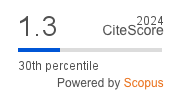Salivary glucose levels and estimation of food intake in type 2 diabetes mellitus patients
Downloads
Background: Saliva, an easily collectible organic fluid, offers a noninvasive means for multiple samplings to determine salivary glucose levels, comparable to blood and potentially helpful in diagnosing and monitoring type 2 diabetes mellitus. Purpose: This research was carried out to determine the value of salivary glucose levels and food intake in patients with type 2 diabetes mellitus. Methods: This research utilized a descriptive quantitative method with a cross-sectional approach. The study population comprised type 2 diabetes mellitus patients in Bandung and Jatinangor. The samples, consisting of 27 individuals from each group—type 2 diabetes mellitus patients and healthy participants—were collected through purposive sampling. Saliva was collected using the spitting method and measured to determine salivary glucose levels (mg/dL). Food intake per day (in grams) was assessed using a semi-quantitative food frequency questionnaire and converted using NutriSurvey 2007. Results: Among the 27 participants with type 2 diabetes mellitus, salivary glucose levels were found to be ≥2 mg/dL (mean 23.47 mg/dL), whereas in the healthy group, 5 participants (18.5%) exhibited salivary glucose levels <2 mg/dL (mean 8.29 mg/dL). Most type 2 diabetes mellitus patients and healthy participants reported food intake below the Indonesian dietary recommendations. Conclusion: In our limited sample, salivary glucose levels in type 2 diabetes mellitus patients were higher compared to healthy participants. Energy intake in both groups showed similar results. Salivary glucose levels and BMI exhibited a correlation, though notably weak in this study.
Downloads
Situmorang PC, Zuhra CF, Lutfia A, Pasaribu KM, Hardiyanti R, Nugraha AP. Harnessing phytochemicals to combat diabetes: Insights into molecular pathways and therapeutic advances. J Funct Foods. 2025; 128: 106799. doi: https://doi.org/10.1016/j.jff.2025.106799
Magliano DJ, Boyko EJ. IDF Diabetes atlas. 10th ed. Brussels: International Diabetes Federation; 2021. web: https://www.ncbi.nlm.nih.gov/books/NBK581934/
Badan Penelitian dan Pengembangan Kesehatan. Riset kesehatan dasar 2018. Jakarta: Kementerian Kesehatan Republik Indonesia; 2018. p. 127–41. web: https://layanandata.kemkes.go.id/katalog-data/riskesdas/ketersediaan-data/riskesdas-2018
Badan Penelitian dan Pengembangan Kesehatan. Riset kesehatan dasar 2013. Jakarta: Kementerian Kesehatan Republik Indonesia; 2013. p. 89. web: https://layanandata.kemkes.go.id/katalog-data/riskesdas/ketersediaan-data/riskesdas-2013
Betteng R, Pangemana D, Mayulu N. Analisis faktor resiko penyebab terjadinya diabetes melitus tipe 2 pada wanita usia produktif di Puskesmas Wawonasa. J e-Biomedik. 2014; 2(2): 404–12. doi: https://doi.org/10.35790/ebm.2.2.2014.4554
Ghadge KK, Shetty SK, Kulloli A, Martande S, Mehta V, Gopalakrishnan D, Mathur A, Fiorilla L. The effect of non-surgical periodontal therapy on glycemic control in Indian diabetics with periodontal disease – A systematic review and meta-analysis. Dent J. 2025; 58(2): 198–206. doi: https://doi.org/10.20473/j.djmkg.v58.i2.p198-206
Mulawarmanti D, Widyastuti W. Effect of oxygen hyperbaric therapy on malondialdehyde levels in saliva of periodontitis patients with type 2 diabetes mellitus. Dent J (Majalah Kedokt Gigi). 2008; 41(4): 151–4. doi: https://doi.org/10.20473/j.djmkg.v41.i4.p151-154
Narmada IB, Laksono V, Nugraha AP, Ernawati DS, Winias S, Prahasanti C, Dinaryanti A, Susilowati H, Hendrianto E, Ihsan IS, Rantam FA. Regeneration of salivary gland defects of diabetic Wistar rats post human dental pulp stem cells intraglandular transplantation on acinar cell vacuolization and interleukin-10 serum level. Pesqui Bras Odontopediatria Clin Integr. 2019; 19(1): 1–10. doi: https://doi.org/10.4034/PBOCI.2019.191.144
Tiongco R, Bituin A, Arceo E, Rivera N, Singian E. Salivary glucose as a non-invasive biomarker of type 2 diabetes mellitus. J Clin Exp Dent. 2018; 10(9): e902-7. doi: https://doi.org/10.4317/jced.55009
Badan Penelitian dan Pengembangan Kesehatan. Hasil utama riset kesehatan dasar. Jakarta: Kementerian Kesehatan Republik Indonesia; 2018. p. 123–6. web: https://layanandata.kemkes.go.id/katalog-data/riskesdas/ketersediaan-data/riskesdas-2018
Olsson K, Ramne S, González-Padilla E, Ericson U, Sonestedt E. Associations of carbohydrates and carbohydrate-rich foods with incidence of type 2 diabetes. Br J Nutr. 2021; 126(7): 1065–75. doi: https://doi.org/10.1017/S0007114520005140
Bonsembiante L, Targher G, Maffeis C. Type 2 diabetes and dietary carbohydrate intake of adolescents and young adults: what is the impact of different choices? Nutrients. 2021; 13(10): 3344. doi: https://doi.org/10.3390/nu13103344
Park SH, Yao J, Chua XH, Chandran SR, Gardner DSL, Khoo CM, Müller-Riemenschneider F, Whitton C, van Dam RM. Diet and physical activity as determinants of continuously measured glucose levels in persons at high risk of type 2 diabetes. Nutrients. 2022; 14(2): 366. doi: https://doi.org/10.3390/nu14020366
Sumintarti S, Rahman F. Korelasi kadar glukosa saliva dengan kadar glukosa darah terhadap terjadinya kandidiasis oral pada penderita diabetes melitus (Correlation of salivary glucose level and blood glucose level with oral candidiasis in diabetes mellitus patient). J Dentomaxillofacial Sci. 2015; 14(1): 29–31. doi: https://doi.org/10.15562/jdmfs.v14i1.422
Zhang W, Du Y, Wang ML. Noninvasive glucose monitoring using saliva nano-biosensor. Sens Bio-Sensing Res. 2015; 4: 23–9. doi: https://doi.org/10.1016/j.sbsr.2015.02.002
Pérez-Ros P, Navarro-Flores E, Julián-Rochina I, Martínez-Arnau FM, Cauli O. Changes in salivary amylase and glucose in diabetes: a scoping review. Diagnostics. 2021; 11(3): 453. doi: https://doi.org/10.3390/diagnostics11030453
Subramani SK, Yadav D, Mishra M, Pakkirisamy U, Mathiyalagen P, Prasad G. Prevalence of type 2 diabetes and prediabetes in the Gwalior-Chambal Region of Central India. Int J Environ Res Public Health. 2019; 16(23): 4708. doi: https://doi.org/10.3390/ijerph16234708
Venkatachalam J, Muthukumar T, Muthu RE, Singh Z. BMI, physical activity and diabetes- a case control study in a rural area of Kancheepuram district of Tamil Nadu. J Compr Heal. 2020; 4(1): 49–56. doi: https://doi.org/10.53553/JCH.v04i01.006
Al-Hadi H, Zurriyani Z, Saida SA. Prevalensi diabetes melitus tipe 2 dengan kejadian hipertensi di Poliklinik Penyakit Dalam RS Pertamedika Ummi Rosnati. J Med Malahayati. 2020; 4(4): 291–7. doi: https://doi.org/10.33024/jmm.v4i4.3484
Przezak A, Bielka W, Pawlik A. Hypertension and type 2 diabetes—the novel treatment possibilities. Int J Mol Sci. 2022; 23(12): 6500. doi: https://doi.org/10.3390/ijms23126500
Haryati AI, Tyas TAW. Perbandingan kadar HbA1c pada pasien diabetes melitus tipe 2 yang disertai hipertensi dan tanpa hipertensi di Rumah Sakit Umum Daerah Duri, Mandau, Bengkalis, Riau. J Kedokt dan Kesehat. 2022; 18(1): 33–40. doi: https://doi.org/10.24853/jkk.18.1.33-40
Pratama Putra IDGI, Wirawati IAP, Mahartini NN. Hubungan kadar gula darah dengan hipertensi pada pasien diabetes mellitus tipe 2 di RSUP Sanglah. Intisari Sains Medis. 2019; 10(3): 797–800. doi: https://doi.org/10.15562/ism.v10i3.482
Gupta S, Nayak M, Sunitha J, Dawar G, Sinha N, Rallan N. Correlation of salivary glucose level with blood glucose level in diabetes mellitus. J Oral Maxillofac Pathol. 2017; 21(3): 334–9. doi: https://doi.org/10.4103/jomfp.JOMFP_222_15
Choudhry AA, Kumar P, Prasad M, Mohapatra T, Sharma P. Validation of salivary glucose as a screening tool of diabetes mellitus. Rom J Intern Med. 2022; 60(3): 145–52. doi: https://doi.org/10.2478/rjim-2022-0005
Sukmawati, Sudewi S, Pontoh J. Optimasi dan validasi metode analisis dalam penentuan kandungan total flavonoid pada ekstrak daun gedi hijau (Abelmoschus manihot L.) yang diukur dengan spektrofotometer UV-VIS. Pharmacon. 2018; 7(3): 32–41. web: https://ejournal.unsrat.ac.id/index.php/pharmacon/article/view/20117
Cui Y, Zhang H, Wang S, Lu J, He J, Liu L, Liu W. Obtaining a reliable diagnostic biomarker for diabetes mellitus by standardizing salivary glucose measurements. Biomolecules. 2022; 12(10): 1335. doi: https://doi.org/10.3390/biom12101335
Samkani A, Skytte MJ, Kandel D, Kjaer S, Astrup A, Deacon CF, Holst JJ, Madsbad S, Rehfeld JF, Haugaard SB, Krarup T. A carbohydrate-reduced high-protein diet acutely decreases postprandial and diurnal glucose excursions in type 2 diabetes patients. Br J Nutr. 2018; 119(8): 910–7. doi: https://doi.org/10.1017/S0007114518000521
Menteri Kesehatan Republik Indonesia. Peraturan menteri kesehatan nomor 28 tahun 2019 tentang angka kecukupan gizi yang dianjurkan untuk masyarakat Indonesia. 28 Indonesia; 2019 p. 33. web: https://peraturan.bpk.go.id/Details/138621/permenkes-no-28-tahun-2019
Suprapti D. Hubungan pola makan karbohidrat, protein, lemak, dengan diabetes mellitus pada lansia. J Borneo Cendekia. 2017; I(1): 8–12. web: https://jurnal.itskesicme.ac.id.stikeskusumabangsa.ac.id/index.php/jib/article/view/449
Haryono M, Handayani OWK. Analisis tingkat stres terkait kadar gula darah pada penderita diabetes melitus tipe II. Indones J Public Heal Nutr. 2021; 1(3): 657–65. web: https://journal.unnes.ac.id/sju/IJPHN/article/view/49018
Nuraini P, Witjaksono FI, Lestari W. Analisis asupan makronutrien terhadap resistensi insulin. Prepotif J Kesehat Masy. 2022; 6(2): 1878–83. doi: https://doi.org/10.31004/prepotif.v6i2.5383
Copyright (c) 2025 Dental Journal

This work is licensed under a Creative Commons Attribution-ShareAlike 4.0 International License.
- Every manuscript submitted to must observe the policy and terms set by the Dental Journal (Majalah Kedokteran Gigi).
- Publication rights to manuscript content published by the Dental Journal (Majalah Kedokteran Gigi) is owned by the journal with the consent and approval of the author(s) concerned.
- Full texts of electronically published manuscripts can be accessed free of charge and used according to the license shown below.
- The Dental Journal (Majalah Kedokteran Gigi) is licensed under a Creative Commons Attribution-ShareAlike 4.0 International License

















